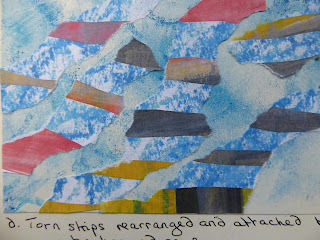The second quote is from Nigel Hurlstone who in 2010 referred to "the potential of machine embroidery to create a new and different language that does not duplicate the original source, but breathes into it a different life that celebrates the haptic qualities of stitch and the unpredictability of cloth and thread as a way to leave an imprint of thought, time, process and the hand of the maker on and within a surface."
And so I began ...
Fig. 3:1
Sample 1 is straight stitch with normal tension on both top and bottom. We were asked to think of words such as flowing, jerky, calm or twisty as we stitched. To be honest I found it hard enough to control my stitching into definite patterns without thinking of words as well but actually, with hindsight, the patterns do reflect these words.
Fig. 3:2
Sample 2 is of zigzag stitch with a mix of normal even tension top and bottom and tight top tension with loose bottom tension. These latter samples were far less successful and I really dislike their appearance. I shall persevere however!
Fig. 3:3
Sample 3 is part straight stitch, part zigzag with the top tension as tight as it will go (setting 9). My machine will not easily allow me to lower the tension on the spool thread but I think these samples are a reasonable approximation of the whip stitch samples shown in the course notes and I'm happy with the effect of the contrasting spole thread showing through. I'm also beginning to feel a little more in control of the stitching.
Fig. 3:4
And finally Sample 4 is cable stitch with a normal top tension and the hand wound spool thick threads completely bypassing the spool chase. The matt white thread in the top left hand samples is a fine coton-a-broder. The other white threads are a shiny rayon twist. The turquoise block is a 4-ply acrylic knitting yarn and proved to be a complete revelation when I turned my work over as I certainly was not expecting this effect from purely rows of straight stitch! The lime green samples are using a fine rayon tubular yarn and the pale green is a thicker coton-a-broder.
I admit that I was really not expecting to like the cable stitch samples but the tubular yarn and the 4-ply acrylic have produced some very interesting effects. A lot of thread doesn't go very far though so maybe they are really only useful for quite small areas as I certainly don't have unlimited quantities of either of these threads.




































